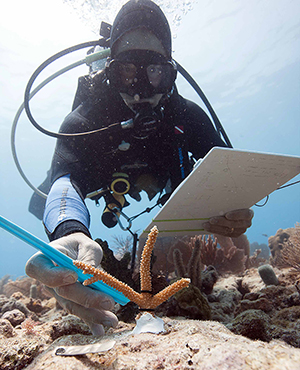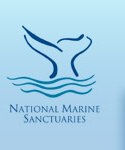Thousands of nursery raised corals find homes on the reef
 Erich Bartels of Mote Marine Lab prepares to place nursery-grown coral fragments at a transplant site off Big Pine Key, Fla. Photo by Tim Calver.
Erich Bartels of Mote Marine Lab prepares to place nursery-grown coral fragments at a transplant site off Big Pine Key, Fla. Photo by Tim Calver.This spring and summer, scientists are transplanting thousands of nursery-grown staghorn and elkhorn corals to degraded reefs in the sanctuary, south Florida and the U.S. Virgin Islands in the largest marine restoration project of its kind. Florida Keys National Marine Sanctuary and its research partners hope that the transplanted young corals will thrive and reproduce, helping to recover populations of these two threatened species.
In 2009, through a grant from NOAA's Restoration Center and the American Recovery and Reinvestment Act, scientists with The Nature Conservancy, Coral Restoration Foundation, Florida Fish and Wildlife Conservation Commission, Mote Marine Laboratory, Nova Southeastern University, and University of Miami RSMAS began growing staghorn and elkhorn corals at eight underwater nurseries located from Ft. Lauderdale south through the Florida Keys and U.S. Virgin Islands. In these underwater nurseries, scientists nurtured, clipped and propagated these branching corals while cataloging the genetic lineage of each fragmented coral nubbin.
 Erich Bartels of Mote Marine Lab measures newly outplanted coral near Looe Key. Photo by Tim Calver.
Erich Bartels of Mote Marine Lab measures newly outplanted coral near Looe Key. Photo by Tim Calver.The NOAA-funded project initially aimed to grow 12,000 coral colonies, but instead raised 30,000 of the fast-growing branching corals. Up to 10,000 of these staghorn and elkhorn colonies, ranging from the size of tennis balls to soccer balls, are scheduled to be transplanted before the end of 2012 and the majority of them within the sanctuary.
In 2006, staghorn and elkhorn corals became the first corals to be listed as threatened under the Endangered Species Act. In the Florida Keys and Tortugas, populations of these iconic corals have suffered serious decline since the 1970s due to disease, coral bleaching and hurricanes.
Restoration scientists have strategically selected transplant locations in the sanctuary to maximize genetic diversity and the chance of sexual reproduction.
To learn more about these protected corals and threats to their health, read Elkhorn Coral: Science of Recovery (pdf, 382 kb).


